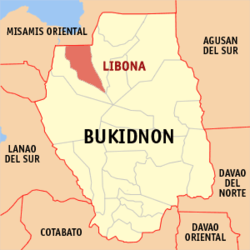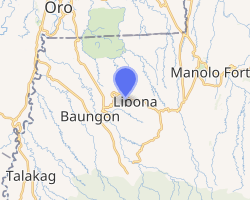Libona, Bukidnon
Libona, officially the Municipality of Libona (Bukid and Higaonon: Banuwa ta Libona; Cebuano: Lungsod sa Libona; Tagalog: Bayan ng Liboba), is a 1st class municipality in the province of Bukidnon, Philippines. According to the 2015 census, it has a population of 43,969 people.[3]
Libona | |
|---|---|
| Municipality of Libona | |
 Seal | |
 Map of Bukidnon with Libona highlighted | |
OpenStreetMap 
| |
.svg.png) Libona Location within the Philippines | |
| Coordinates: 8°20′N 124°44′E | |
| Country | |
| Region | Northern Mindanao (Region X) |
| Province | Bukidnon |
| District | 1st District |
| Founded | October 4, 1957 |
| Barangays | 14 (see Barangays) |
| Government | |
| • Type | Sangguniang Bayan |
| • Mayor | Aurelio B. Lopez |
| • Vice Mayor | Leonardo Genesis T. Calingasan |
| • Congressman | Ma. Lourdes O. Acosta-Alba |
| • Electorate | 27,798 voters (2019) |
| Area | |
| • Total | 374.37 km2 (144.55 sq mi) |
| Population (2015 census)[3] | |
| • Total | 43,969 |
| • Density | 120/km2 (300/sq mi) |
| • Households | 9,919 |
| Economy | |
| • Income class | 1st municipal income class |
| • Poverty incidence | 37.38% (2015)[4] |
| • Revenue (₱) | 147,947,803.01 (2016) |
| Time zone | UTC+8 (PST) |
| ZIP code | 8706 |
| PSGC | |
| IDD : area code | +63 (0)88 |
| Climate type | tropical rainforest climate |
| Native languages | Binukid Cebuano Ata Manobo Tagalog |
| Website | www |
Libona is situated in the northern part of the province and is approximately 103 kilometers from Malaybalay, the capital city of Bukidnon. The municipality can be reached from Cagayan de Oro, the major trade center of Northern Mindanao, through a 52 kilometer-route passing Barangay Alae of Manolo Fortich, or through a 32 kilometer road northward passing Barangay Indahag, Cagayan de Oro.
History
According to history, gold had flourished in the locality that prompted people from the neighboring towns flocked into this place in their quest for the golden fame and fortune. It was said that on January 17, 1817, A Spanish soldier who was on patrol was tasked to write down the names of the places he would come across within the course of his mission. He happened to pass by a group of men who were digging gold on one of the gold mines. Talking in Spanish, the soldier inquired about the name of the place. The natives, who did not understand the language, thought the soldier was asking them how many gold stones they have already gathered. In response, they answered “libo na” meaning a thousand already. The Spanish soldier jotted the word “Libona” in his record book believing it was the name of the locality.
Libona was once a Municipal District of Maluko, now the Municipality of Manolo Fortich, Bukidnon, created under EO No. 5 dated April 4, 1917 issued by then acting Governor Ponciano C. Reyes of the defunct Department of Mindanao and Sulu. Due to its progressive stride in both the socio-economic and political infrastructure, Libona was finally able to separate itself from her mother municipality when it was granted political identity. then President Carlos P. Garcia, issued EO No. 272, dated October 4, 1957 declaring Libona a regular municipality. By virtue of the said order, Libona became the 14th municipality in the province of Bukidnon.
Climate
| Climate data for Libona, Bukidnon | |||||||||||||
|---|---|---|---|---|---|---|---|---|---|---|---|---|---|
| Month | Jan | Feb | Mar | Apr | May | Jun | Jul | Aug | Sep | Oct | Nov | Dec | Year |
| Average high °C (°F) | 25 (77) |
25 (77) |
26 (79) |
27 (81) |
27 (81) |
26 (79) |
26 (79) |
26 (79) |
26 (79) |
26 (79) |
26 (79) |
25 (77) |
26 (79) |
| Average low °C (°F) | 21 (70) |
20 (68) |
20 (68) |
21 (70) |
22 (72) |
22 (72) |
22 (72) |
22 (72) |
22 (72) |
22 (72) |
21 (70) |
21 (70) |
21 (71) |
| Average precipitation mm (inches) | 271 (10.7) |
217 (8.5) |
193 (7.6) |
178 (7.0) |
344 (13.5) |
423 (16.7) |
362 (14.3) |
358 (14.1) |
329 (13.0) |
320 (12.6) |
322 (12.7) |
260 (10.2) |
3,577 (140.9) |
| Average rainy days | 23.2 | 19.5 | 22.0 | 22.8 | 29.6 | 28.9 | 30.3 | 29.8 | 28.1 | 28.8 | 26.1 | 24.1 | 313.2 |
| Source: Meteoblue [5] | |||||||||||||
Barangays
Libona is politically subdivided into 14 barangays.
| PSGC | Barangay | Population | ±% p.a. | |||
|---|---|---|---|---|---|---|
| 2015[3] | 2010[6] | |||||
| 101311001 | Capihan | 5.2% | 2,273 | 2,067 | 1.83% | |
| 101311002 | Crossing | 10.4% | 4,578 | 4,369 | 0.89% | |
| 101311003 | Gango | 14.0% | 6,173 | 4,884 | 4.56% | |
| 101311004 | Kiliog | 5.5% | 2,418 | 1,440 | 10.37% | |
| 101311005 | Kinawe | 9.2% | 4,062 | 3,815 | 1.20% | |
| 101311006 | Laturan | 6.7% | 2,927 | 2,921 | 0.04% | |
| 101311007 | Maambong | 5.1% | 2,239 | 1,917 | 3.00% | |
| 101311008 | Nangka | 4.1% | 1,784 | 1,515 | 3.16% | |
| 101311009 | Palabucan | 3.6% | 1,594 | 1,333 | 3.46% | |
| 101311010 | Poblacion | 7.9% | 3,471 | 3,113 | 2.09% | |
| 101311011 | Pongol | 8.1% | 3,579 | 3,485 | 0.51% | |
| 101311012 | San Jose | 8.5% | 3,738 | 3,387 | 1.90% | |
| 101311013 | Santa Fe | 4.9% | 2,154 | 2,506 | −2.84% | |
| 101311014 | Sil‑ipon | 6.8% | 2,979 | 2,641 | 2.32% | |
| Total | 43,969 | 39,393 | 2.11% | |||
Demographics
| Year | Pop. | ±% p.a. |
|---|---|---|
| 1918 | 1,547 | — |
| 1939 | 3,727 | +4.28% |
| 1948 | 4,406 | +1.88% |
| 1960 | 10,653 | +7.63% |
| 1970 | 14,988 | +3.47% |
| 1975 | 16,481 | +1.92% |
| 1980 | 21,229 | +5.19% |
| 1990 | 29,652 | +3.40% |
| 1995 | 31,897 | +1.38% |
| 2000 | 33,273 | +0.91% |
| 2007 | 35,670 | +0.96% |
| 2010 | 39,393 | +3.68% |
| 2015 | 43,969 | +2.11% |
| Source: Philippine Statistics Authority[3][6][7][8] | ||
In the 2015 census, the population of Libona, Bukidnon, was 43,969 people,[3] with a density of 120 inhabitants per square kilometre or 310 inhabitants per square mile.
Local government
Municipal officials (2013-2016):
- Mayor: Leonardo Genesis T. Calingasan
- Vice Mayor: Aurelio B. Lopez
- Sangguniang Bayan Members:
- Vicentico A. Buta
- Ernie Al O. Edralin
- Eterio P. Tanquis
- Vicente F. Balais
- Fernando P. Ibarita
- Vladimir P. Gallego
- Alejandro G. Buenaflor
- Farrah L. Yongco
Liga ng mga Barangay President: Eleazar P. Ibona
Indigenous Peoples Mandatory Representative: Ernie P. Calingasan
Education
- Primary
- Libona counted over 20 Elementary School that caters the youth in the different barangays in the municipality.
- Secondary
- Libona National High School (Crossing)
- Kinawe National High School (Kinawe)
- Hossana Academy of Bukidnon Inc. (Gango)
- Tertiary
- Bukidnon State University - Libona Extension Studies Center (Poblacion)
References
- "Municipality". Quezon City, Philippines: Department of the Interior and Local Government. Retrieved 31 May 2013.
- "Province: Bukidnon". PSGC Interactive. Quezon City, Philippines: Philippine Statistics Authority. Retrieved 12 November 2016.
- Census of Population (2015). "Region X (Northern Mindanao)". Total Population by Province, City, Municipality and Barangay. PSA. Retrieved 20 June 2016.
- "PSA releases the 2015 Municipal and City Level Poverty Estimates". Quezon City, Philippines. Retrieved 12 October 2019.
- "Libona: Average Temperatures and Rainfall". Meteoblue. Retrieved 29 April 2020.
- Census of Population and Housing (2010). "Region X (Northern Mindanao)". Total Population by Province, City, Municipality and Barangay. NSO. Retrieved 29 June 2016.
- Censuses of Population (1903–2007). "Region X (Northern Mindanao)". Table 1. Population Enumerated in Various Censuses by Province/Highly Urbanized City: 1903 to 2007. NSO.
- "Province of Bukidnon". Municipality Population Data. Local Water Utilities Administration Research Division. Retrieved 17 December 2016.